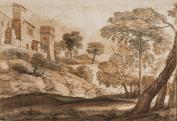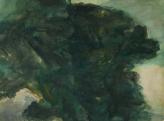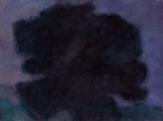2024. November 26. Tuesday
Budapest Museum of Fine Arts - Budapest
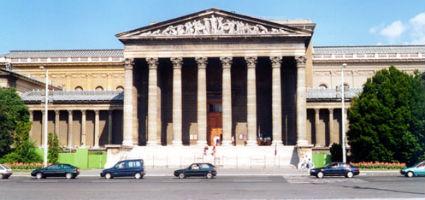 |
Address: 1146, Budapest Dózsa György út 41.
Phone number: (1) 469-7100
E-mail: info@szepmuveszeti.hu
Opening hours: Tue-Sun 10:00-18:00
|
2023.11.09. - 2024.03.17.
Museum tickets, service costs:
|
Ticket for adults
(valid for the permanent exhibitions)
|
2800 HUF
|
/ capita
|
|
Ticket for adults
|
3200 HUF
|
|
|
Group ticket for adults
|
2900 HUF
|
|
|
Ticket for students
(valid for the permanent exhibitions)
|
1400 HUF
|
/ capita
|
|
Ticket for students
|
1600 HUF
|
|
|
Group ticket for students
|
1400 HUF
|
|
|
Ticket for pensioners
(valid for the permanent exhibitions)
|
1400 HUF
|
/ capita
|
|
Audio guide
|
800 HUF
|
|
|
Video
|
1000 HUF
|
Gateways in Existence presents works by contemporary artist Alexandre Hollan, born in Hungary (Budapest, 1933) and now residing in France, in the company of depictions of trees and landscapes by some of the most prominent masters in the history of European drawing and printmaking. Besides works by Hollan, viewable from 9 October in the recently revamped exhibition hall of the Museum of Fine Arts are compositions by the great classics of tree depictions and landscape art, including Wolfgang Huber, Pieter Bruegel the Elder, Jan Brueghel the Elder, Claude Lorrain, Camille Corot, Rembrandt and Nicolas Poussin.
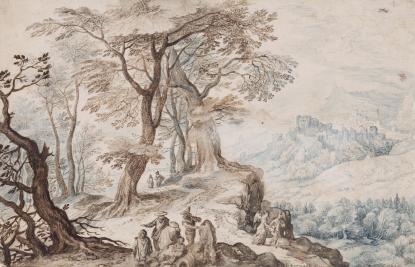
The selection of more than fifty outstanding works not only exemplifies some of the pinnacles of European landscape art but also offers an overview of the different techniques ofgraphic art: pen-and-ink drawing, coloured woodcut, copperplate engraving, etching, cliché-verre and acrylic painting. This is all made possible by the rich holdings of the Collection of Prints and Drawings at the Museum of Fine Arts, Budapest, including the significant group of artworks donated to the museum by Alexandre Hollan himself between 2003 and 2019. The Hungarian-born artist, a sensitive observer of the inner forces of trees, has gifted more than 150 of his works to the museum since 2003, of which an important selection of twenty-four pieces can be seen at this exhibition.
Alexandre Hollan left Hungary in 1956. The young artist was welcomed into the École nationalesupérieure des Beaux-Arts in Paris to complete his studies there. In the cold seasons, his atelier ties him to Paris, while he spends his summers in Gignac, in the south of France, where, roaming the countryside, he revisits his favourite trees and by observing their subtlest vibrations produces meditative drawings with the delicate touch of the charcoal or the brush.
Following Baselitz X Schiavone, the first show to have opened in the Exhibition Hall of Prints and Drawings after its reopening in the summerof 2023, visitors can again see works by a contemporary artist displayed in parallel with relevant pieces by the old masters. Drawings and prints by old masters set in dialogue with Hollan’s works at this exhibition are examinations from different periods of the relationship btweenhumans and nature, and of the symbolic ways in which trees can be interpreted. In addition, they tackle universal questions of art that have long posed challenges to artists through the eras: how to form a portrait of a tree, how to depict a wooded landscape, how to exploit the latent possibilities of drawing directly in front of the motif, how to portray the forces of nature, how to convey the light phenomena found in nature, and how to shift away from objective reality. Among the great masters admired for their landscapes and their depictions of trees – Wolfgang Huber, Pieter I Bruegel, Jan I Brueghel, Claude Lorrain, to mention just a few –, we have selected works by artists who specifically inspired Hollan, whom he mentions in his writings and interviews, and whose works he even paraphrased (Rembrandt Harmensz. van Rijn, Nicolas Poussin).
In our day and age, when the act of planting a tree may be prompted not only by a desire to embellish our surroundings or to preserve a memory but as a gesture of common concern about the future of our planet, we may rightly ask: What are the messages of trees, the vital fellow constituents of our habitat, as conveyed through the searching gaze of artists? How do trees appear in the different ages of art, in the most immediate and personal medium of the creative process, the art of drawing? After all, drawing a tree means observing it in detail and connecting with it intimately, unlocking its magical message.
The notion of the symbiotic coexistence of trees and people has been present in the beliefs, languages and artistic creations of the most diverse cultures since prehistoric times. According to the Book of Psalms, the blessed one is “like a tree planted by streams of water, which yields its fruit in season and whose leaf does not wither – whatever they do prospers” (Psalm 1:3). Poetic associations abound in ancient literature as well: in the Iliad, Homer compares the valiant heroes to high oak trees.Among the myths related by Ovid, the story about unrequited love with Daphne turned into a laurel tree was a popular theme for Renaissance and Baroque painters (Metamorphoses, I. 438–567). With their roots clinging firmly to the ground and their leafy branches reaching to the sky, trees connect heaven and earth; they are messengers of wisdom, constant renewal, and hope – even today.

The selection of more than fifty outstanding works not only exemplifies some of the pinnacles of European landscape art but also offers an overview of the different techniques ofgraphic art: pen-and-ink drawing, coloured woodcut, copperplate engraving, etching, cliché-verre and acrylic painting. This is all made possible by the rich holdings of the Collection of Prints and Drawings at the Museum of Fine Arts, Budapest, including the significant group of artworks donated to the museum by Alexandre Hollan himself between 2003 and 2019. The Hungarian-born artist, a sensitive observer of the inner forces of trees, has gifted more than 150 of his works to the museum since 2003, of which an important selection of twenty-four pieces can be seen at this exhibition.
Alexandre Hollan left Hungary in 1956. The young artist was welcomed into the École nationalesupérieure des Beaux-Arts in Paris to complete his studies there. In the cold seasons, his atelier ties him to Paris, while he spends his summers in Gignac, in the south of France, where, roaming the countryside, he revisits his favourite trees and by observing their subtlest vibrations produces meditative drawings with the delicate touch of the charcoal or the brush.
Following Baselitz X Schiavone, the first show to have opened in the Exhibition Hall of Prints and Drawings after its reopening in the summerof 2023, visitors can again see works by a contemporary artist displayed in parallel with relevant pieces by the old masters. Drawings and prints by old masters set in dialogue with Hollan’s works at this exhibition are examinations from different periods of the relationship btweenhumans and nature, and of the symbolic ways in which trees can be interpreted. In addition, they tackle universal questions of art that have long posed challenges to artists through the eras: how to form a portrait of a tree, how to depict a wooded landscape, how to exploit the latent possibilities of drawing directly in front of the motif, how to portray the forces of nature, how to convey the light phenomena found in nature, and how to shift away from objective reality. Among the great masters admired for their landscapes and their depictions of trees – Wolfgang Huber, Pieter I Bruegel, Jan I Brueghel, Claude Lorrain, to mention just a few –, we have selected works by artists who specifically inspired Hollan, whom he mentions in his writings and interviews, and whose works he even paraphrased (Rembrandt Harmensz. van Rijn, Nicolas Poussin).
In our day and age, when the act of planting a tree may be prompted not only by a desire to embellish our surroundings or to preserve a memory but as a gesture of common concern about the future of our planet, we may rightly ask: What are the messages of trees, the vital fellow constituents of our habitat, as conveyed through the searching gaze of artists? How do trees appear in the different ages of art, in the most immediate and personal medium of the creative process, the art of drawing? After all, drawing a tree means observing it in detail and connecting with it intimately, unlocking its magical message.
The notion of the symbiotic coexistence of trees and people has been present in the beliefs, languages and artistic creations of the most diverse cultures since prehistoric times. According to the Book of Psalms, the blessed one is “like a tree planted by streams of water, which yields its fruit in season and whose leaf does not wither – whatever they do prospers” (Psalm 1:3). Poetic associations abound in ancient literature as well: in the Iliad, Homer compares the valiant heroes to high oak trees.Among the myths related by Ovid, the story about unrequited love with Daphne turned into a laurel tree was a popular theme for Renaissance and Baroque painters (Metamorphoses, I. 438–567). With their roots clinging firmly to the ground and their leafy branches reaching to the sky, trees connect heaven and earth; they are messengers of wisdom, constant renewal, and hope – even today.


